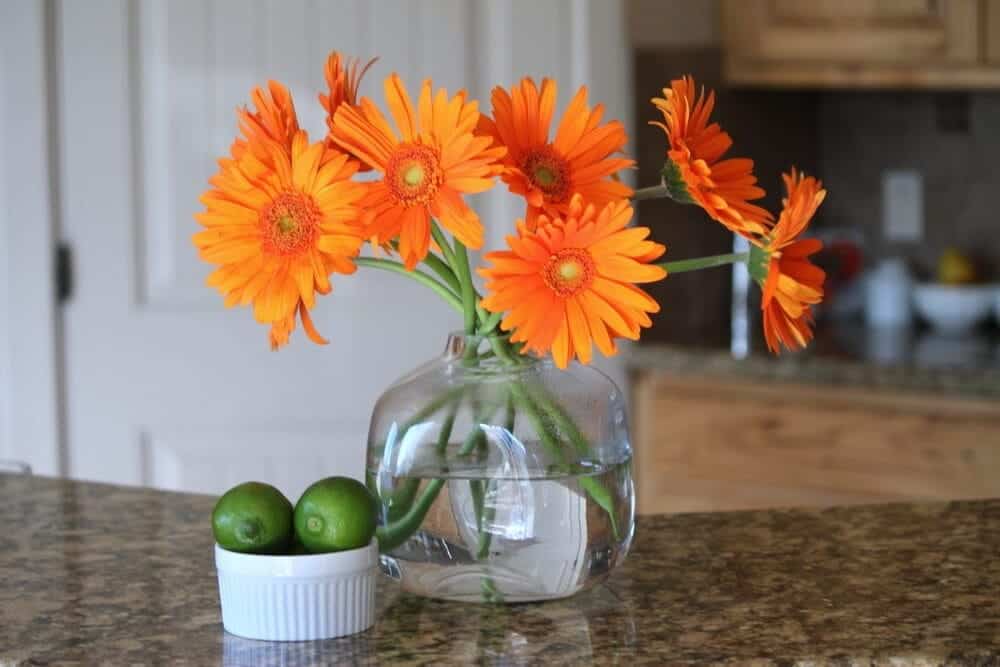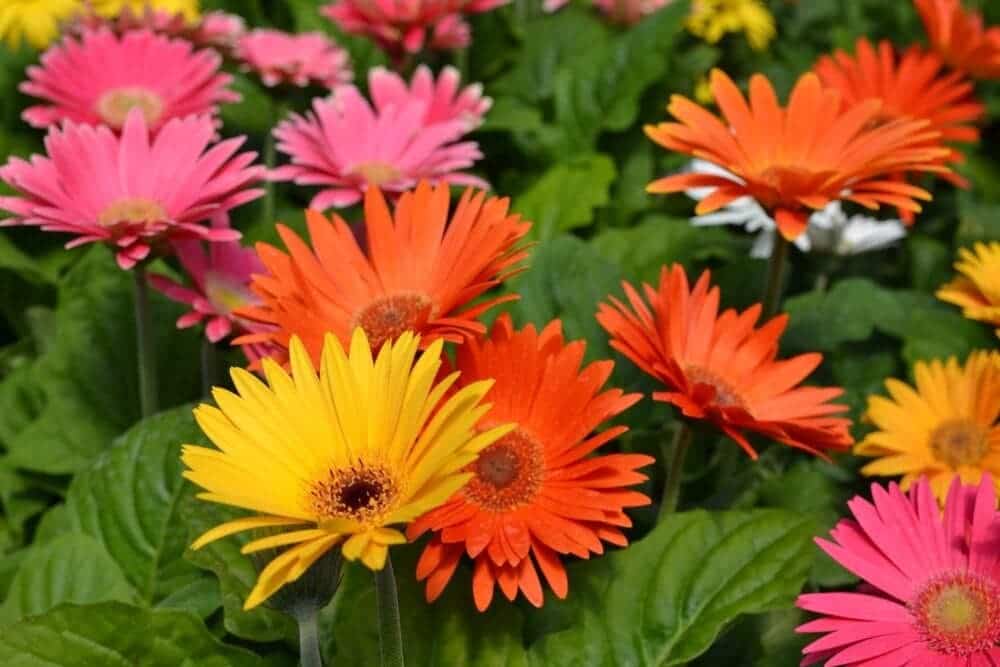Do you want a plant that is known for its cheerful, bright flowers? Gerbera Daisy is plants that can be grown indoors or outdoors.
They are easy to grow and make a great addition to your yard or home. It is one of the florist’s favorite flowers. It is the fifth most popular flower in the world.
Gerbera Daisy Care & Growing Guide
1. Light Requirement
Although Gerbera Daisy is a big fan of the sun, it prefers the shade of the afternoon and morning sun. They will need more shade if the temperatures reach 80 degrees Fahrenheit or higher. They will require two to three hours of shade daily in those temperatures.
When growing indoors, have the plant placed so it is facing the west or south window. In the winter when there is not much natural sunlight, you can use artificial lights.
2. Water
Once a week, you should deeply water your Gerbera Daisy. When you deeply water them, the rule of thumb is to soak below the soil surface at least eight inches. The reason is that their roots grow deep. For temperatures that are 85 degrees Fahrenheit or higher, you may need to deep water it two times a week instead of once.
Indoor plants should be watered when the topsoil is a little dry.
3. Climate
The USDA hardiness zone is 8-11. In zone 8, they will need protection during the winter.
4. Soil
The pH of the soil should be 5.5-6.6. For inside potting, you should use a potting mixture that is free from any contamination and is light. It should also be rich in organic material and a bit sandy so it does not retain moisture.
5. Temperature
The temperature should range from 40-70 degrees Fahrenheit. The best temperatures would be between 70-75 degrees Fahrenheit. They are a frost-tender perennial but any frost will cause damage.

6. Repotting
When potting indoors, the pot should be 12 x 12 inches with five draining holes. You need to use a light potting mix that is well-draining. Dig up the daisies from outdoors, bringing it inside with the entire root ball. Put the plant in a hole in the middle of the pot, cover, and pack the roots with soil. Once repotted, water them deeply and then only when the top one inch deep is dry. It needs to have afternoon shade and direct morning sun.
7. Speed of Growth
When planting from seeds, you need to do this about 12-18 weeks before the last frost so they will be ready to plant. It takes the seeds two to four weeks to germinate.
8. Height and Spread
The bloom of a daisy can measure as wide as four to five inches across. It grows low to the ground naturally in a group of green leaves. They can reach six to ten inches deep when in a pot.
9. Flowers
The petals of the Gerbera Daisy are satin-looking that surround a distinct center. They come in a variety of colors such as snowy white, ruby red, bright pink, and sunny yellow, to name a few.
10. Trimming
When trimming the Gerbera Daisy, you want to remove any fading flowers. To do this, pinch off the stem at the base of the flower. You can also cut it off.

Is Gerbera Daisy Poisonous?
The Gerbera Daisy is not toxic to pets or humans, but if an animal ingests any, it could cause gastrointestinal discomfort for your pet.
Can Gerbera Daisy grow in Water?
No, they cannot grow in the water. The seeds need to be planted in seed pots for the plants to grow.
More like this: Amazon Lily Care & Growing guide
How to get Gerbera Daisy to Flower?
You get them to flower by trimming off the fading flowers. This will give the plant energy to redirect to new growth and blooms. It also signals the plant to produce seeds.
Common Gerbera Daisy Plant Diseases
Gerbera Daisy can be prone to a variety of diseases, including:
- Pests—these can include plant lice or aphids, which you can control with herbicides. You can also pick them off or lightly spray the leaves with jets of water. Make sure that the plant dries to prevent other problems.
- Grey mildew—this can happen if the conditions are very damp. To keep this from happening, make sure that the leaves and flowers are left to dry. When watering them, try to avoid getting the leaves wet. If growing in a greenhouse, make sure it is well aerated.
- Root rot—to prevent either, make sure that there is adequate drainage. These are caused by the plant remaining in soggy soil and standing water.
- Crown rot—this happens when the crowns are planted too deeply. Make sure that the crowns are visible above the soil. Let them dry between each time you water them.
- Chlorosis—this is when the leaves have yellow stripes. To prevent this keep the acidic pH level below 6.5. If it is lower than 5.5, then you may see black patches or spots on the leaves.
Also read:
Conclusion
- You should start the growing process in early spring. Start growing the seeds indoors and then transplant outside in late spring or early summer.
- Use a balanced or blooming fertilizer, feeding from spring to mid-fall. You should do this every two to three weeks. Do not stop fertilizing in the winter if you live in a frost-free climate or growing them in a greenhouse.
- Make sure the fertilizer contains manganese, iron, and magnesium as Gerbera Daisy is prone to these deficiencies. Without these nutrients, the Gerbera Daisy will not be a healthy plant or develop their gorgeous, vibrant flower colors.
- When putting them in a vase, they can last as long as two weeks.
- They are one of the best air-purifying plants.
- Gerbera Daisy is an annual plant, which means that when it dies back in the winter, it will re-grow year after year.
- When you water Gerbera Daisy, use warm water instead of cold water. Cold water can cause dark patches and spots to develop on the leaves.
- Although they can be grown outdoors, they work best in a planter.

Victoria is the owner and main author of hobby plants. She loves spending her free time in her garden planting and taking care of her plants. Victoria hopes you enjoy the content here!
![Queen Of The Night Flower [Complete Plant Care Guide] Queen Of The Night Flower [Complete Plant Care Guide]](https://www.hobbyplants.com/wp-content/uploads/2022/07/queen-of-the-night-flower-300x158.jpg)
![Mother Of Thousands Plant [Complete Plant Care Guide] Mother Of Thousands Plant [Complete Plant Care Guide]](https://www.hobbyplants.com/wp-content/uploads/2022/07/mother-of-thousands-plant-300x158.jpg)
![How Often Should You Water Pothos? [Complete Care Guide] How Often Should You Water Pothos? [Complete Care Guide]](https://www.hobbyplants.com/wp-content/uploads/2022/07/how-often-to-water-pothos-300x158.jpg)
![Can Snake Plants Live Outside? [COMPLETE CARE GUIDE] Can Snake Plants Live Outside? [COMPLETE CARE GUIDE]](https://www.hobbyplants.com/wp-content/uploads/2022/08/can-snake-plants-live-outside-300x158.jpg)
![Majesty Palm Plant Care: [Complete Beginner's Guide] Majesty Palm Plant Care: [Complete Beginner's Guide]](https://www.hobbyplants.com/wp-content/uploads/2022/08/majesty-palm-care-300x158.jpg)
![Exotic Angel Plant Care: [Complete Beginner's Guide] Exotic Angel Plant Care: [Complete Beginner's Guide]](https://www.hobbyplants.com/wp-content/uploads/2022/08/exotic-angel-plant-care-300x158.jpg)
![Do Coleus Like Sun Or Shade: [Complete Care Guide] Do Coleus Like Sun Or Shade: [Complete Care Guide]](https://www.hobbyplants.com/wp-content/uploads/2022/08/coleus-sun-or-shade-300x158.jpg)
![Snow White Waffle Plant: [Complete Care Guide] Snow White Waffle Plant: [Complete Care Guide]](https://www.hobbyplants.com/wp-content/uploads/2022/08/snow-white-waffle-plant-300x158.jpg)
![Waffle Plant Care: [Complete Beginner's Guide] Waffle Plant Care: [Complete Beginner's Guide]](https://www.hobbyplants.com/wp-content/uploads/2022/08/waffle-plant-300x158.jpg)
![Bird Of Paradise Plant Care: [Complete Beginner's Guide] Bird Of Paradise Plant Care: [Complete Beginner's Guide]](https://www.hobbyplants.com/wp-content/uploads/2022/08/bird-of-paradise-plant-300x158.jpg)
![Purple Passion Plant Care: [Complete Beginner's Guide] Purple Passion Plant Care: [Complete Beginner's Guide]](https://www.hobbyplants.com/wp-content/uploads/2022/08/purple-passion-plant-care-300x158.jpg)
![China Doll Plant Care: [Complete Beginner's Guide] China Doll Plant Care: [Complete Beginner's Guide]](https://www.hobbyplants.com/wp-content/uploads/2022/09/china-doll-plant-care-300x158.jpg)